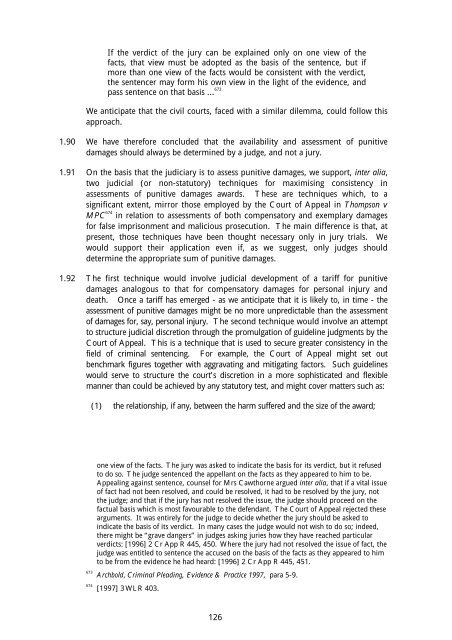Aggravated, Exemplary and Restitutionary ... - Law Commission
Aggravated, Exemplary and Restitutionary ... - Law Commission
Aggravated, Exemplary and Restitutionary ... - Law Commission
You also want an ePaper? Increase the reach of your titles
YUMPU automatically turns print PDFs into web optimized ePapers that Google loves.
If the verdict of the jury can be explained only on one view of the<br />
facts, that view must be adopted as the basis of the sentence, but if<br />
more than one view of the facts would be consistent with the verdict,<br />
the sentencer may form his own view in the light of the evidence, <strong>and</strong><br />
pass sentence on that basis ... 673<br />
We anticipate that the civil courts, faced with a similar dilemma, could follow this<br />
approach.<br />
1.90 We have therefore concluded that the availability <strong>and</strong> assessment of punitive<br />
damages should always be determined by a judge, <strong>and</strong> not a jury.<br />
1.91 On the basis that the judiciary is to assess punitive damages, we support, inter alia,<br />
two judicial (or non-statutory) techniques for maximising consistency in<br />
assessments of punitive damages awards. These are techniques which, to a<br />
significant extent, mirror those employed by the Court of Appeal in Thompson v<br />
MPC 674<br />
in relation to assessments of both compensatory <strong>and</strong> exemplary damages<br />
for false imprisonment <strong>and</strong> malicious prosecution. The main difference is that, at<br />
present, those techniques have been thought necessary only in jury trials. We<br />
would support their application even if, as we suggest, only judges should<br />
determine the appropriate sum of punitive damages.<br />
1.92 The first technique would involve judicial development of a tariff for punitive<br />
damages analogous to that for compensatory damages for personal injury <strong>and</strong><br />
death. Once a tariff has emerged - as we anticipate that it is likely to, in time - the<br />
assessment of punitive damages might be no more unpredictable than the assessment<br />
of damages for, say, personal injury. The second technique would involve an attempt<br />
to structure judicial discretion through the promulgation of guideline judgments by the<br />
Court of Appeal. This is a technique that is used to secure greater consistency in the<br />
field of criminal sentencing. For example, the Court of Appeal might set out<br />
benchmark figures together with aggravating <strong>and</strong> mitigating factors. Such guidelines<br />
would serve to structure the court’s discretion in a more sophisticated <strong>and</strong> flexible<br />
manner than could be achieved by any statutory test, <strong>and</strong> might cover matters such as:<br />
(1) the relationship, if any, between the harm suffered <strong>and</strong> the size of the award;<br />
one view of the facts. The jury was asked to indicate the basis for its verdict, but it refused<br />
to do so. The judge sentenced the appellant on the facts as they appeared to him to be.<br />
Appealing against sentence, counsel for Mrs Cawthorne argued inter alia, that if a vital issue<br />
of fact had not been resolved, <strong>and</strong> could be resolved, it had to be resolved by the jury, not<br />
the judge; <strong>and</strong> that if the jury has not resolved the issue, the judge should proceed on the<br />
factual basis which is most favourable to the defendant. The Court of Appeal rejected these<br />
arguments. It was entirely for the judge to decide whether the jury should be asked to<br />
indicate the basis of its verdict. In many cases the judge would not wish to do so; indeed,<br />
there might be “grave dangers” in judges asking juries how they have reached particular<br />
verdicts: [1996] 2 Cr App R 445, 450. Where the jury had not resolved the issue of fact, the<br />
judge was entitled to sentence the accused on the basis of the facts as they appeared to him<br />
to be from the evidence he had heard: [1996] 2 Cr App R 445, 451.<br />
673 Archbold, Criminal Pleading, Evidence & Practice 1997, para 5-9.<br />
674 [1997] 3 WLR 403.<br />
126
















